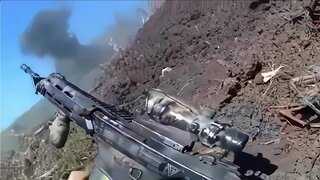The Effect, Accuracy & Trajectory Of High Caliber AA Tracers Used For Direct Fire Support
Video footage captured in Syria shows the effect, accuracy and trajectory of a common high caliber anti-air tracers used for direct fire support against fixed ground positions.
The weapon system that was mounted on a pickup truck and has been used in some sort of shoot-and-scoot tactic appears to be a ZU-23 23 mm anti-aircraft twin-barreled autocannon.
ZU stands for Zenitnaya Ustanovka (Russian: Зенитная Установка) – anti-aircraft mount.
The ZU-23-2 (2A13) mounts two 23 mm autocannons on a small trailer which can be converted into a stationary mount for firing the guns. While in this position the wheels are moved aside. The autocannon can be prepared for firing from the march position in 30 seconds and in emergency can be fired from the traveling position. The weapon is aimed and fired manually, with the help of the ZAP-23 optical-mechanical sight which uses manually entered target data to provide limited automatic aiming. It also has a straight-tube telescope T-3 for use against ground targets such as infantry as well as unarmored or lightly armoured vehicles. The ammo is fed by a conveyor belt from two ammunition boxes. Each of the ammunition boxes is located on the side of the twin autocannon and each carries 50 rounds. The fumes created by firing the weapon are partially removed through the side openings in the barrels.
Normally, once each barrel has fired 100 rounds it becomes too hot and is therefore replaced with a spare barrel. Each weapon is normally provided with two replacement barrels as part of its standard equipment. Tulamashzavod Joint Stock Company is offering to upgrade the 2A14 guns to the 2A14M standard with a barrel life of 10,000 rounds instead of 8,000 rounds.
The cannon carriage is based on the earlier ZPU-2 anti-aircraft twin heavy machine gun, which mounted two KPV 14.5 mm heavy machine guns. ZU-23-2 can be identified by different placement of the ammunition boxes (at right angles to the gun carriage) and by muzzle flash suppressors. In another similarity to the ZPU series, single-barrel and four-barrel versions of the ZU-23 were also developed. However, these versions never entered service.
The ZU-23-2 can be towed by a number of different vehicles. In USSR and later Russia the most frequently used towing vehicles for it were GAZ-66 4x4 trucks and GAZ-69 4x4 light trucks.
The ZU-23-2 first entered service with the Soviet Army in 1960. The gun is often mounted on trucks for use in both anti-aircraft and direct fire support roles. It can also be mounted on the roof of the MT-LB multi-purpose tracked APCs. A specially modified three-legged ZU-23-2 autocannon is used as the base for the BTR-DG airborne SPAAG. Cheap, easy to operate and still effective, the ZU-23-2 is still used by the Russian Army and by more than 20 other armies.
In the Soviet Union, some 140,000 units were produced. The ZU-23 has also been produced under licence by Bulgaria, Poland, Egypt and the People's Republic of China.
WarLeaks - Military Blog covers events, news, missions & facts from the United States Armed Forces including the U.S. Army, U.S. Navy, U.S. Marine Corps, Air Force, Coast Guard and more! Furthermore you will find content about military weapons, weapon systems and technology here. All footage on this channel is footage the Ultimate Military Archive has permission to use or consists of derivative works created by the WarLeaks - Military Blog for educational and informational purposes. The appearance of U.S. Department of Defense visual information on the WarLeaks - Military Blog does not imply or constitute Department of Defense endorsement.
►SUBSCRIBE to the WarLeaks - Military Blog for more military videos: http://bit.ly/Nnic4n
►FOLLOW WARLEAKS on INSTAGRAM at https://instagram.com/WARLEAKSOFFICIAL
►FOLLOW WARLEAKS on FACEBOOK at https://FB.com/WARLEAKER
If you like military content please remember to leave a Like & Comment or even Share the video. It means a lot. Thanks!
-
 9:13
9:13
WarLeaks - Military Blog
11 months ago🔴 Ukraine War Update - Massive Ukrainian Offensive Operations in Donetsk & Zaporizhia Regions
1.23K -
 3:41:38
3:41:38
The Jimmy Dore Show
1 day agoThe Jimmy Dore Live Panel Show
160K162 -
 8:02:15
8:02:15
SNEAKO
13 hours agoFRESH EDATE, SPECIAL GUEST, BIG STREAM
150K89 -
 LIVE
LIVE
Fed Reacts
15 hours agoFed Explains The Disappearance of Madeleine McCann
1,409 watching -
 2:24:44
2:24:44
vivafrei
1 day agoEp. 211: Trump Trial, Jack Smith, Tyson Loses, Ukraine, Russia V. Google & MORE!
180K378 -
 3:02:10
3:02:10
Due Dissidence
1 day agoSeinfeld Show INTERRUPTED by Protests, Police CRACK DOWN on Nakba March, Cardi B TRASHES Biden
102K87 -
 15:48
15:48
PARAGRAPHIC
1 day agoThe Largest Reptile Sanctuary in the United States | PARAGRAPHIC
47.3K20 -
 27:45
27:45
Adam Does Movies
20 hours ago'The Strangers: Chapter 1' Is Hot Garbage - SPOILERS!
46K15 -
 8:33
8:33
MichaelBisping
1 day agoBISPING Reacts: "Tyson Fury COULDN'T Keep The Pace!" | Tyson Fury vs Oleksandr Usyk Reaction
54.1K23 -
 9:56
9:56
Misha Petrov
20 hours agoTragic Leftist Transformations
64.1K66